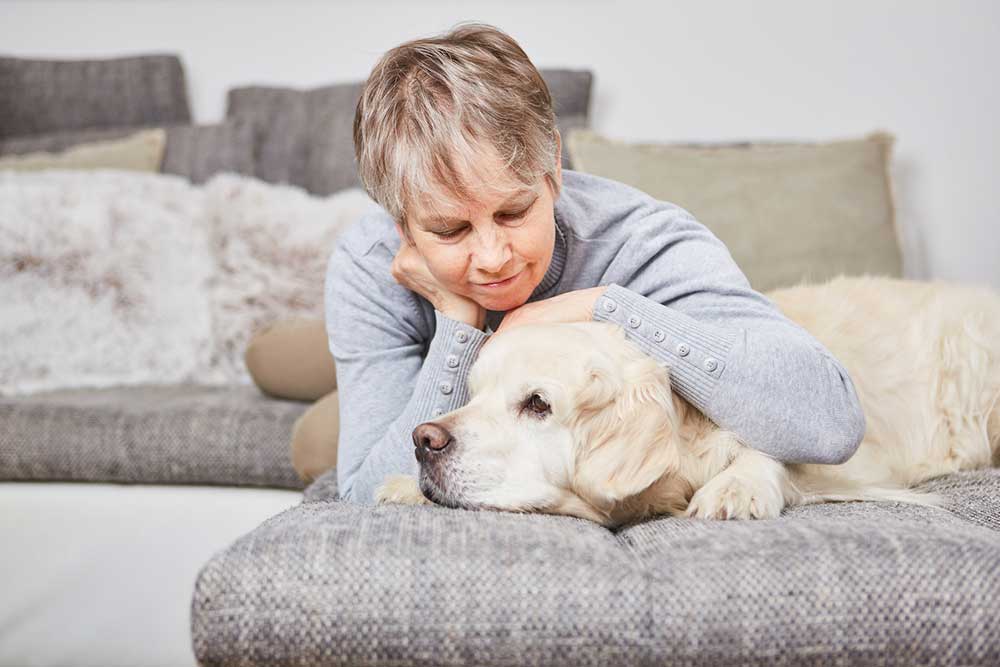Nobody wants to think about “the Big C," but there's hardly anyone who hasn't been touched by it at some point — including our pets. Cancer is the leading cause of death in older dogs, and statistically 1 in 4 dogs will be diagnosed with cancer at some point in their lives. It's estimated that around six million cancer cases are diagnosed in dogs in the United States each year.
This is why regular vet checkups are important, as well as understanding the early symptoms of cancer in dogs so that you can get them checked out and begin treatment like surgery, chemotherapy and radiation therapy ASAP.
Currently cancer is not curable. Learning to recognize the signs that your dog may be dying of cancer will help you and your vet develop an end-of-life pet care plan for them through the final stages, whether that means pain management and palliative care or giving them a peaceful exit through euthanasia.
Stages of Cancer in Dogs
Stages of cancer are determined by the size of the tumor, whether it's invading any vital organs or systems and whether it's localized or has spread to the lymph nodes or other organs. For dogs, cancer is broken down into three common stages: T, N and M.
- T: Tumor size
- N: Whether or not the cancer is in the lymph nodes or lymphatic system
- M: Whether the cancer has metastasized (spread) to other parts of the body
In the early stages, chances are higher that a tumor can be removed via surgery or respond well to chemotherapy and other treatments. In the late stages, the tumor has grown or metastasized — that is, it has spread to other parts of the body. The more the cancer spreads, the worse the prognosis. The end stage of cancer usually means that the tumor has spread too much to be operable and has stopped responding to treatment. At this stage, it may be time to begin end of life preparations.
11 Signs Your Dog May Be Dying from Cancer
While some advanced symptoms depend on the type of cancer your dog has, here are some signs and symptoms during the final stage of cancer, indicating that your dog may have reached the end of their life.
1. Drastically reduced appetite
Your dog might eat less, or they might lose interest in food altogether. A number of things could cause this, including nausea, pain, obstructions in the throat or esophagus, gastrointestinal issues or loss of smell.
2. Persistent vomiting or diarrhea
Cancers that affect the lymphatic system as well as the liver, spleen and abdominal area can cause stomach distress, resulting in frequent vomiting and diarrhea as the cancer progresses.
3. Difficulty eating
Oral melanoma and other cancers affecting the mouth or throat can cause pain or obstructions that make it difficult for dogs to chew or swallow, even if there's nothing wrong with their appetite.
4. Drastic weight loss
Each of the above issues can cause your dog to become dramatically thin in the end stages of life. Certain cancers, like liver cancer, can also impact their ability to derive nutrients from their food, resulting in weight loss as well.
5. Loss of energy
Dogs will likely start slowing down as cancer progresses toward the late stages. At the end stage, your dog may be extremely lethargic, wanting to sleep a lot and not wanting to engage in play or exercise.
6. Loss of interest in things they love
As cancer takes its toll on your pup, they may lose interest in toys, activities or even the kind of attention that previously brought them joy. Even though your dog may appear to lose interest in you, be assured that they're still comforted by your presence.
7. Difficulty breathing
Cancer that spreads to the lungs can cause frequent coughing or labored breathing. Lymphoma that enlarges the lymph nodes around the throat might also obstruct the airways and cause snoring and noisy breathing.
8. Wounds or ruptures
Tumors that are on or close to the skin may rupture and cause bleeding or cause tender skin that bruises easily. These wounds can be prone to infections that may need to be treated by a vet. Internal tumors may also rupture, causing internal bleeding.
9. Unusual bleeding
Some types of late-stage cancer may cause blood to appear in urine or feces, or bleeding from the nose or mouth. Uncontrollable or persistent bleeding should be treated as a veterinary emergency. And as mentioned above, visible bleeding can also indicate the possibility of internal bleeding — another reason to have your vet see your pup right away.
10. Pain
Your dog may show signs of pain that include whining, crying and other vocalizations; licking or chewing affected areas; or guarding the areas of the body where they hurt. They may even growl or snap when you try to touch them.
11. Difficulty moving or getting around
Pain and lack of energy can both cause your dog to have trouble getting up and down or walking. Cancer that gets into the joints can also cause stiffness that can lead to limping, lameness and even paralysis.
How to Help a Dog During Cancer's Final Stages
In the final stages of cancer, your pup's decline might be rapid, or spread out over weeks or months. It's important to stay in touch with your vet and communicate any changes in your fur baby's condition.
Your vet will be able to help you develop a strategy for end-of-life care, which may include shifting the focus of treatment from fighting the cancer to mitigating its symptoms, keeping your dog comfortable and improving their quality of life as long as possible. Your vet can also help you assess whether it's time to consider euthanasia, although they can't make that decision for you.
Here are some other ways you can help your dog when things take a turn for the worse:
- Feed them a nutritious diet adapted to their needs. There is no one-size-fits-all best dog food for dogs with cancer since every case is different. Some dogs do well with a commercial prescription oncological diet that's low in carbohydrates and glucose (which feed cancer cells) and high in protein and fat. However, dogs with liver issues may need the opposite. It's best to talk to your vet and possibly also consult a veterinary nutritionist to tailor a diet to your dog's particular dietary needs.
- Pay close attention to changes in their appetite and take action when needed. Talk to your vet right away if your dog stops eating or can't keep food down. Anti-nausea medications or appetite stimulants might help. Warming your pup's food might also make it more appetizing for them. You could also try adding bone broth or a food topper to their food or changing their food to something with more flavor or a stronger smell.
- Support their immune system. Between the cancer itself and chemotherapy, your dog is likely to have a weakened immune system that makes them more susceptible to illnesses and infections. Talk to your vet about giving them supplements like echinacea, mushrooms and probiotics to help strengthen their immunity, as well as taking steps to prevent exposing them to contagions.
- Provide lots of clean, fresh water. If you have trouble getting them to drink water, you can also try adding it to their food or adding other fluids like bone broth to keep them hydrated. Keeping their water next to their bed so they don't have to walk far to drink might also help.
- Keep them comfortable and provide plenty of rest. Give them a soft bed with orthopedic support and place it in a quiet spot where they can rest without being disturbed. An electric warming dog bed can also help relieve stiff or sore joints and other aches and pains they might experience.
- Adapt their favorite activities to their energy level. Your pup might not be able to go on walks anymore, but they might enjoy being carted around the block in a wagon or carried in a sling. Take them for a car ride with the window down and visit their favorite places so they can see the sights and enjoy the smells. Encourage them to play with their favorite toys, engage in their favorite games or go on short walks on days when they have more energy. And don't underestimate how much joy simply napping in a sunny spot can bring your dog.
- Just be there for them. Make the most of your pup's good days, and just be near them and show them love on their bad days. As the end draws nearer, they may not be able to return your affection like they once did, but that doesn't mean they don't enjoy being petted and talked to and reassured by your presence.
Coping When Your Dog Is Dying of Cancer
Caring for a dog who is terminally ill takes an emotional toll. You might be wrestling with anticipatory grief, fear and anxiety, guilt, anger, frustration and sheer exhaustion. While all of your attention might be focused on your dog, it's important to make time for self-care. It's also important to remember that your vet is on your team and is there to provide support and answer questions, so don't worry that you're bothering them if you have any concerns regarding your dog's treatment or condition.
Finding someone you can talk to for emotional support can also help. Lap of Love connects grieving pet parents with support groups, grief counselors and other resources to help you cope with each stage of losing your pet.
Knowing what to expect as your dog's cancer progresses and how to recognize the warning signs that the end is approaching will help you gain a measure of control as you plan for their final days and prepare yourself to say goodbye.
CareCredit Credit Card Financing for Cancer Treatment
Cancer in pets is complex and we're still learning more about it every day. If your pet needs cancer treatment, the costs can add up quickly. Fortunately, the CareCredit credit card can help you manage the costs of your pet's veterinary care, including treatments like surgery and chemotherapy.* Use our Acceptance Locator to find a veterinarian near you that accepts CareCredit. Join our community by downloading the CareCredit Mobile App to manage your CareCredit account, find a provider on the go and easily access the Well U blog for more helpful articles, podcasts and videos.
In addition to pet care, you can also use your CareCredit credit card for dentistry, cosmetic, vision, hearing, health systems, dermatology, pharmacy purchases, spa treatments and so much more within the CareCredit network. How will you invest in your health and wellness next?
Expert Reviewer
Dr. Kathy Wentworth, V.M.D.
Dr. Kathy Wentworth was the Medical Director of the VCA PetPoint Medical Center and Resort, located in Irvine, California. She is a graduate of the University of Pennsylvania's School of Veterinary Medicine and became board-certified as a Diplomate in Canine and Feline Practice by the American Board of Veterinary Practitioners in 2010.
Featured Video Care Expert
Dr. Jeff Werber, D.V.M.
Dr. Jeff Werber has been a practicing veterinarian for 39 years and sees his patients at Value Vet in Westwood, California. In September of 1997, Werber became the pet expert for CBS News in Los Angeles, where he was awarded an Emmy for his pet health reporting. He is currently a frequent contributor to CNN, E! Entertainment, KCBS/KCAL-Los Angeles, KTLA and Inside Edition.
Author Bio
Jean Marie Bauhaus is a freelance writer and novelist who has been writing pet content since 2013. Her work has appeared on Forbes.com, Hill's Pet, Chewy, AKC.org and more.










